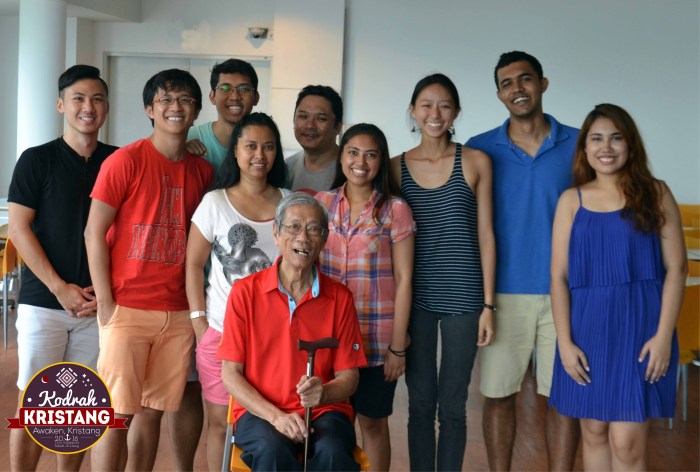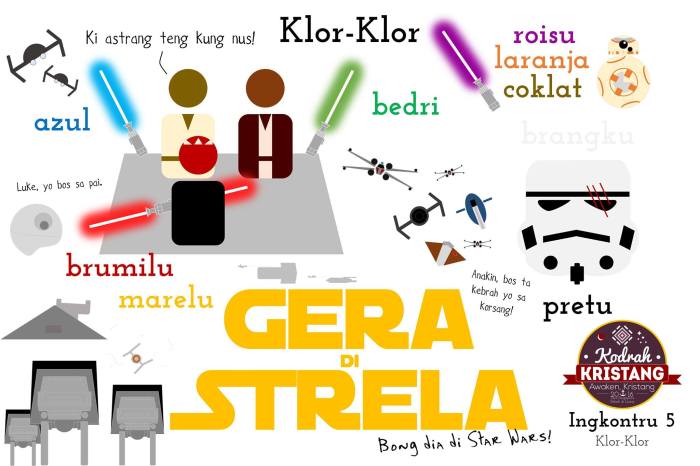Of course, Kristang, being a creole of Portuguese and Malay, isn’t every Singaporean Eurasian’s mother tongue. Eurasians of other threads of heritage may count many other languages—German, Khmer, Thai, French, for example—among their wealth of mother tongue inheritance.
But since my four grandparents all were of Portuguese-Eurasian heritage (my maternal grandmother’s maiden name was Sequeira, my maternal grandfather was a Pinto, my paternal grandfather a De Silva, and my paternal grandmother’s family name was Pereira), for me Kristang is truly my mother tongue.

My maternal grandmother, Patsy Sequeira, and her son Conrad Pinto.

My maternal grandfather, Cyril Pinto.

My paternal grandmother Margarita (Aggie) Pereira (left, in sarong kebaya) and her family in Malacca.

My paternal grandfather, Harry Alphonso Maria De Silva, and his daughter Maude at her First Communion.
Since March this year, I’ve been attending Kristang lessons on Saturday mornings at the School of Alice and Peter Tan at NUS. The 2-hour lessons are conducted by final-year linguistics major Kevin Martens Wong. Kevin is 24 and he basically learned Kristang on his own by reading up (and memorising!) the scant available material on the language, such as dictionaries and books and poetry collections written by an amazing Malaysian Eurasian Kristang activist by the name of Joan Marbeck. http://joanmarbeck.com
Kevin is also the editor of an awesome online magazine on languages called Unravel. You can read a fantastic article he wrote on Kristang here:
http://unravellingmag.com/articles/kristang-a-shallow-sea/
“The word Kristang is believed to be derived from the Portuguese word cristão, meaning, as it were, ‘Christian’. It stands not just for the language, papia kristang (‘Christian speech’) but also for a people for whom it is clearly evident in the singular use of this term that the Christian identity is a significant part of their tradition.”
— Kevin Martens Wong, ‘Kristang: A shallow sea’, Unravel, Issue 3
With Kevin teaching us the formal stuff like grammar and vocabulary and Mr Bernard Mesenas, a fluent elderly Kristang speaker, teaching us about Eurasian culture like proverbs and recipes for corned beef cutlets and Eurasian stew, our little class of under 20 people has come surprisingly far in a very short time.
After just a few lessons we are able to speak in full sentences in Kristang! We can now say stuff like:
I want to go home to sleep = Yo kereh bai casa bai drumi
I ate at Ya Kun with my friends = Yo jah kumi na Ya Kun kung yo sa kamradu
Amazing right??

Kristang teachers Kevin Martens Wong (second from left) and Bernard Mesenas (seated). Kristang learners from left: Dominic Ng, Fuad Johari, Mary Thomas Anthony, Kevin Michael Sim, Eleanor Thomas, Frances Loke Wei, Anirudh Krishnan and Sabrina Noronha
How we achieved this feat was through the many fun and engaging slides and games Kevin designed. For Star Wars Day on 4th May, he did a hilarious slide to teach us colours (= Klor-Klor):

See that tiny line on the left? Luke, yo bos sa pai = Luke, I am your father (haha!)
Starting in July is another round of classes.

For those who can’t make it, Kevin and his friends have also recently come up with a fantastic podcast to teach Kristang to absolute beginners.
Being able to speak in (simple!) Kristang with my course mates makes me feel more Eurasian. And I finally feel like I have more of my own culture, which to be honest, I didn’t feel like I had very much to begin with.
As Eurasians, we are a people who do not have many visible, tangible traits to show our culture. We cannot boast of having unique beaded slippers, say, like the Peranakans, or a legacy of dynastic culture like the Chinese, or a wealth of literature, art and song like those from the Indian subcontinent. But what we do have, besides our awesome Eurasian cuisine—debal, feng, ambilla, sugee cake!!—is this language, which is truly ours.
Unlike, the Christian religion, which many of us Eurasians share with others in Singapore and around the world, the Kristang language is the one thing that is truly ours. Even with our Eurasian cuisine, there is overlap for example, with Indian and Chinese versions of sugee cake, Peranakan variations of buah keluak curry and chap chye, vindaloo from India.
But Kristang… Kristang is ours.
So… come join us, either for the beginners’ class (Kristang 1) or the elementary (Kristang 2, where my current course mates and myself will be come July). It’s fun, promise!
Beng nos papiah Kristang! = Come, let’s speak Kristang!
Melissa



Interesting piece, learnt so much!
LikeLike
Glad to hear it Zee, thanks! 🙂
LikeLike
Very interesting. Wish I could speak kristang. I live in Australia, is there a book on the language that I could buy?
LikeLike
hi Jackie! You surely will be able to learn.. like we are. Joan Marbeck, the Kristang activist in Malaysia, has put out a few books. You can check them out at http://joanmarbeck.com and could contact her (through the site) to get hold of them. Of course, the podcasts (there will be more coming) are a great way to start.
Resources in Kristang are exactly what we need right now…I have been thinking of creating picture books/ early readers in Kristang 🙂
LikeLike
Will u ever have a have a course where one can attend, say a 2 week course. I ask because I live in Perth, am retired and would love to learn my Mother-Tongue. Tks
LikeLike
hi Dennis, it’s not myself who is running the Kristang course but Kevin Martens Wong. He has thought of holding an intensive live-in somewhere, maybe in Malaysia or Singapore, for a few days or w weekend where people who are beginners/ elementary speakers can focus only on speaking and learn Kristang together. I could pass Kevin your email address if you like, so he can notify you as and when such a course materialises 🙂
LikeLike
My dear young Singapore ‘ Kristangs’. I am so very proud of you. Because of you and your belief in yourself, your true identity and heritage, you have emerged champions of your Community……..and for so many others who have a distinct, unique Heritage worth publishing to the World.
Yo fikah mutu tantu gabadu pra bosa tudu interessa na gadrah nus sa Linggu, nus sa Adanza pra mas tantu anu na forah!! Mutu grandi merseh kung ung abrasah! Joan. M. Marbeck
LikeLike
Wow! I never knew that my Dad was so handsome in his younger days. How did you get hold of the photo Melissa?
LikeLike
haha Godpa! I have a hard copy of the photo I believe, and Kenneth has a digital version in his online album. Will send you the link.
LikeLike
Ah hang on, Kenneth doesn’t have it in his album.. I have a scan of it. Will send it to you 🙂
LikeLike
Very cool that you are keeping tradition alive and moreover that young people embrace it. Kudos to all of you!!
LikeLike
hi Ramon, thanks so much! It’s so encouraging to hear from people like yourself who are also into keeping our Eurasian traditions alive! 😀
LikeLike
How to join the casses..erm…in KL?
LikeLike
Hi Dianne, the classes are held in Singapore for now. What I can suggest is to learn the basics from Kevin’s podcast first. If you like, I could pass him your email address and he could let you know if there is a future course in Malaysia.
LikeLike
Pingback: Reclaiming My Portuguese-Eurasian Mother Tongue, Kristang | The Independent
Pingback: Reclaiming My Portuguese-Eurasian Mother Tongue, Kristang – Kaypoh
Would you be planning on holding classes in the East?
LikeLike
Hi Petrina. You can email kodrahkristang@gmail.com to ask.
LikeLike
I guess that I would learn it Ok. Close to Portuguese…
LikeLike
Hi Melissa,
My name is Kathleen and I’m from KL, originally from Malacca. My parents’ house in Malacca (Ujong Pasir) is a mere 10-minute walk from the Portuguese Settlement. I came across your website as I was clearing my emails and found that you have liked some of my posts (thank you!). Although I’m not Portuguese Eurasian – I’m half Nyonya Peranakan (on mum’s side) – I’m very familiar with the Portuguese culture especially your food! Love curry debal chicken, pork vindaloo and my absolute favourite is sugee cake!! It’s very rare to get sugee cake in KL, as such I only get the chance to eat them during Christmas when my maternal aunt has the time to bake or we order from a family friend in the Settlement. I believe some of our food (Portuguese and Peranakan) share the same heritage due to cross-cultural exchanges over the decades or centuries 🙂
Cheers,
Kat
LikeLike
Pingback: an endangered language | q u i r k y h i l l
I am so glad I have come across your blog. I didn’t know Kristang existed even though I have lived on this island for so many years. Now that I do, I am intrigued to find out even more and perhaps to pick up the basic like you are doing. Thanks for all the links. I will definitely like to learn from the mentioned teachers the moment I can make time to jump into it. I will be coming back to you blog for more on your learning journey. Cheers. 🙂
LikeLike
Hi Jonathan, thanks a lot and glad you found the post interesting and useful! Singapore really has such a wealth of linguistic diversity.. something very precious for all of us to celebrate and preserve and keep alive by learning and speaking. Hope to see you at a Kristang class one of these days 🙂
LikeLike
Hi Melissa, I am an engineer and a language blogger ( http://www.neeslanguageblog.com ) from Medan city in Indonesia and I live in Taiwan at this moment. Are there any online groups where I can chat in Kristang? Mutu merseh.
LikeLike
Very nice blog. I am Portuguese. My parents were born on the Acores island of Sao Jorge. I can read your Portuguese and it is very exciting to see people interested in learning their mother language! My parents visited The Portuguese village in Malaca and they said it felt like walking into a village in the Acores. I would love to one day visit the Cristao village there. I too love languages so cheers to your class!
LikeLike